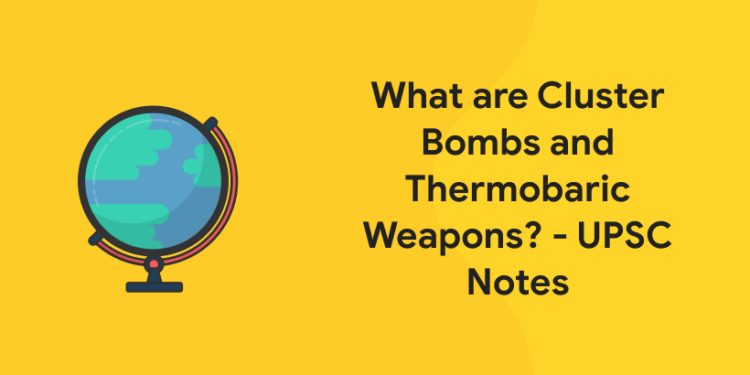Table of Contents
Cluster Bombs and Thermobaric Weapons have been nearly in the news ever since the Russain invasion of Ukraine started on the 24th of Febrary 2022.
According to various news sources, these weapons have been employed in such huge numbers by the Russians that they have been creating massive civilian casualties in Ukrainian cities.
What are Cluster munitions and Thermobaric weapons? What makes them so destructive is that normal conventions of wars stop their arbitrary usage? All of this will be explained in this article within the context of the IAS Exam.
Practise free mock test and ace your government exams! Download Entri App!
- As per the 2008 Convention on Cluster Munitions, a cluster bomb means a “conventional explosive that is created to disperse or release explosive submunitions each weighing less than 20 kilograms, and comprising of those explosive submunitions”.
- Essentially, cluster bombs are non-precision weapons that are created to harm or kill human beings indiscriminately over a large area, and to demolish vehicles and infrastructure such as runways, railway or power transmission lines.
- They can be released from an aircraft or launched in a projectile that spins in flight, scattering many bomblets as it moves.
- Many of these bomblets end up not exploding, but continue to stay on the ground, sometime partially or completely hidden and difficult to find and remove, causing a threat to the civilian population for long after the fighting has stopped.
- The unexploded cluster bombs also cause major long-term environmental damages, as their chemicals can seriously pollute ground water and soil compositions.
What is Thermobaric Weapons?
- Thermobaric weapons are also known as aerosol bombs, fuel air explosives, or vaccum bombs .
- These are known as vacuum bombs as they swallow in oxygen from surrounding areas to produce high-voltage explosions.
- The blast wave is of a larger intensity and time period than conventional bombs and can vapourise humans.
- The weapons can be fired as rockets from tank-mounted launchers or released from aircraft.
- The thermobaric bomb consists of two-stage explosion.
- The first stage changes carbon-based fuel into minute metal particulates, which are discharged as an aerosol.
- The second part explodes the aerosol, changing it into a huge fireball and simultaneously creating an impactful shock wave. Inside this shock wave, a vacuum is created, which draws in the nearby oxygen and exponentially improves the severity of the explosion.
- Thermobaric bombs are destructive and effective in urban areas or open conditions, and can penetrate bunkers and other underground locations, dehydrating the occupants of oxygen.
- There is very little that can save humans and other life forms from their blast and incendiary effects.
Practise free mock test and ace your government exams! Download Entri App!
- Countries that have approved the Convention on Cluster Munitions are not allowed from using cluster bombs.
- As of date, there are 110 state parties to the convention, and 13 other countries have signed up but are yet to approve it. Neither Russia nor Ukraine are signatories.
- Vacuum bombs are not exempted by any international law or agreement, but their use against civilian populations in built-up areas, schools or hospitals, could attract action under the Hague Conventions of 1899 and 1907.
- Amnesty International said international humanitarian law forbids the use of inherently indiscriminate weapons such as cluster munitions.
- Launching indiscriminate attacks that kill or injure civilians constitutes a war crime,
Earlier stances of usage
|
Cluster Bombs and Thermobaric Weapons UPSC notes
Why are some weapons banned, even in wars?
1: Which one of the following is not a Harappan site?
- Although thermobaric weapons are not yet clearly banned, there are many points that argue against their development and use.
- International humanitarian law specifies what is and is not permissible during warfare.
- There has long been an understanding that even wars have their limits: while some weapons are regarded as legal, others are not, precisely because they break vital principles of humanitarian law.
- A new report from Human Rights Watch makes it obvious that the Russian invasion of Ukraine is illegal.
- It draws on the Geneva Conventions to explain the illegitimacy of Moscow’s actions, containing its use or potential use of specific weapons.
- The use of weapons in blind attacks – those that cannot distinguish between combatants and civilians – is prohibited by the Geneva Conventions.
Present Status
- Efforts to prohibit these weapons have not yet reached a clear prohibition. The 1980 Convention on Certain Conventional Weapons (commonly called the “Inhumane Weapons Convention”) addresses incendiary weapons, but states have tried to avoid an explicit ban on thermobaric bombs.
- In addition to the influence on civilians, thermobaric bombs would cause severe injury and unwanted suffering. Under international humanitarian law, they should not be used.
- There is a point at which – even if a war is considered legitimate or “just” – violence must not have weapons that are very cruel or inhumane.
- If a weapon is probably to extend the pain of soldiers (or civilians) or result in severe and unacceptable injuries, theoretically its use is not allowed.
Practise free mock test and ace your government exams! Download Entri App!
- It is these very real dangers that led 122 states at the United Nations to vote in favour of developing the Treaty on the Prohibition of Nuclear Weapons in 2017.
- The war in Ukraine is the latest reminder that we must act to remove thermobaric, cluster, and nuclear weapons, under strict international control.
- The stakes are just too high to permit these dangers to stay.
Convention on Cluster Munitions (CCM)
- Embraced on 30 May 2008, signed on 3 December 2008 and came into action on 1 August 2010.
- The Convention bans all use, production, transfer and stockpiling of cluster munitions.
- Separate articles in the Convention concern destruction of stockpiles, clearance of contaminated areas, assistance to victims, submission of transparency reports, and adoption of domestic legislation.
- Its implementation provides to promoting the achievement of the UN Sustainable Development Goals, the advancement of international peace and security, human rights and international humanitarian law.
How do Cluster Bombs work?
The missile in question clears midair to release small bomblets when cluster bombs are dropped from an aircraft or launched from the ground,. Generally the altitude at which the bomb opens up is between 330 ft and 3,300 ft. How large or small the area of influence will be will depend upon the height, velocity and rotation speed.
An example of a cluster bomb being released from an aircraft. Multiple submunitions are being released from a large bombshell.
How do Thermobaric Weapons work?
The difference between condensed explosive and thermobaric explosive is that when the condense variant uses oxidation to make an explosion from a single source, a thermobaric bomb make use of pressure from within the fuel and oxidant mixture as well as the surrounding air to produce an explosion.
A typical weapon comprises of a container packed with a fuel substance, the center of which has a small conventional-explosive “scatter charge”. Fuels are selected on the basis of the exothermicity of their oxidation, ranging from powdered metals, such as aluminum or magnesium, to organic materials, possibly with a self-contained partial oxidant.
A thermobaric bomb’s effective yield depends on a collection of a number of factors like how well the fuel is dispersed, how fast it combines with the surrounding atmosphere and the initiation of the igniter and its position relative to the container of fuel.
Cluster Bombs and Thermobaric Weapons UPSC notes
Facts about Cluster Munitions and Thermobaric Weapons
- One cluster bomb consists of hundreds of bomblets (or submunitions) and typically breaks them across an area the size of two to four football fields.
- Bomblets are small, usually the size of a ‘D’ battery or a tennis ball and have a failure rate of up to 30 percent; unexploded bomblets become de facto landmines.
- The United States stockpile consists of at least 730 million submunitions.
- Thermobaric and fuel air explosives have been used in guerrilla warfare since the 1983 Beirut barracks bombing in Lebanon, which used a gas-enhanced explosive mechanism that was likely propane, butane, or acetylene.
- International law does not particularly forbid the use of thermobaric munitions, fuel-air explosive devices, or vacuum bombs against military targets. Their use against civilian populations may be banned by the United Nations (UN) Convention on Certain Conventional Weapons (CCW), however they are not explicitly listed.
Practise free mock test and ace your government exams! Download Entri App!
Russia has used thermobaric weapons – also called as vacuum bombs – in Ukraine, says the UK’s Ministry of Defence (MoD). Thermobaric weapons are controversial as they are much more destructive than conventional explosives of similar size, and have a severe impact on anyone caught in their blast radius.
Has Russia used thermobaric weapons in Ukraine?
In a tweet, the MoD said that Russia had confirmed the use of the TOS-1A weapon system in Ukraine. It said: “The TOS-1A make use of thermobaric rockets, generating incendiary and blast effects.” The Russian military calls the units “heavy flamethrowers”, which can fire rockets up to 9km. Ukraine’s ambassador to the US, Oksana Markarova, has also charged with Russia of using them in its invasion.
How does a thermobaric bomb work?
A thermobaric bomb (also called a vacuum or aerosol bomb – or fuel air explosive) comprises of a fuel container with two separate explosive charges. This can be brought out as a rocket or dropped as a bomb from aircraft. When it hits its target, the first explosive charge opens the container and widely scatters fuel mixture as a cloud. This cloud can enter any building openings or defences that are not completely closed.
A second charge then explodes the cloud, causing in a huge fireball, a massive blast wave and a vacuum which swallows up all surrounding oxygen. The weapon can knock down reinforced buildings, equipment and harm or injure people.
They are used for a several purposes and come in a plenty of sizes – including weapons for use by individual soldiers such as grenades and hand-held rocket launchers. Huge air-launched versions have also been developed, particularly to kill defenders in caves and tunnel complexes – the effects of this weapon are at their most serious in enclosed spaces.
In 2003, the US tested a 9,800kg bomb, nicknamed the “Mother of all bombs”. Four years later, Russia created a similar device, the Father of all bombs”. This created an explosion equal to a 44-tonne conventional bomb – making it the biggest non-nuclear explosive device in the world. Given their devastating impact, and their usefulness against defenders who are dug in to buildings or bunkers, thermobaric bombs have mostly been used in urban environments.
This is vital given developments on the ground in Ukraine, where Russian forces are managing to take control of the capital, Kyiv, and other main cities in the east of the country.
What are the rules of war for thermobaric bombs?
There are no international laws specifically banning their use, but if a country uses them to target civilian populations in built-up areas, schools or hospitals, then it could be convicted of a war crime under the Hague Conventions of 1899 and 1907. International Criminal Court prosecutor Karim Khan has said his court will investigate possible war crimes in Ukraine.
Cluster Bombs and Thermobaric Weapons UPSC notes
Where have they been used before?
Thermobaric bombs can be traced back to World War Two, when they were first used by the German army. They were not much developed until the 1960s, when the US used them in Vietnam. The US also used them in Afghanistan. First, in 2001 to try to demolish al-Qaeda forces hiding in the caves of the Tora Bora mountains, and in 2017, against Islamic State forces. Russia used them in its war in Chechnya in 1999 and was condemned by Human Rights Watch for doing so. Russian-made thermobaric weapons were reportedly used in the Syrian civil war by the regime of Bashar al-Assad.











